Little Red Riding Hood, the other version
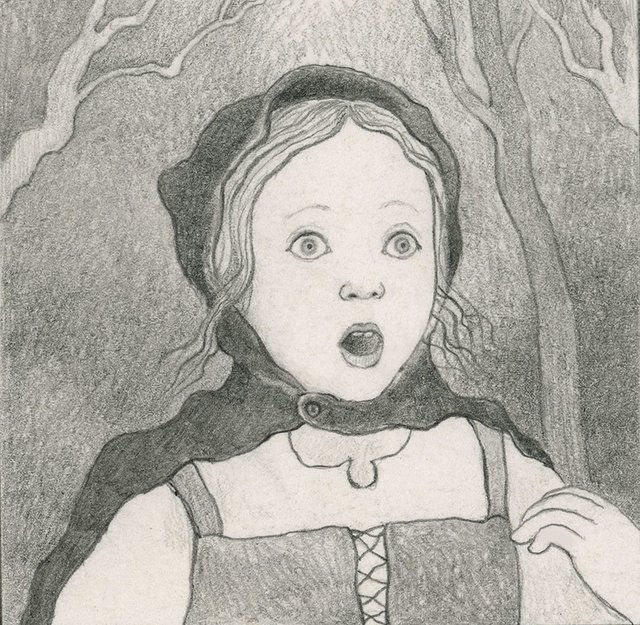
Whether known as Charles Perrault’s Little Red Riding Hood or The Brothers Grimm Little Red Cap, for hundreds of years the story has been told and retold in one form or another.
A little girl is sent into the forest by her mother to bring her ailing grandmother a basket of provisions, encounters a wolf, gets sidetracked, and ultimately lured into a situation she is not prepared to handle. It's easy to see the lessons here. Don’t veer off "the path" or something bad will happen. Be mindful of charming strangers. The wolf symbolizes the dangers of the real world for a young girl. And had she followed her mother’s instructions to not stop for anyone or anything on her way, she could have avoided trouble.
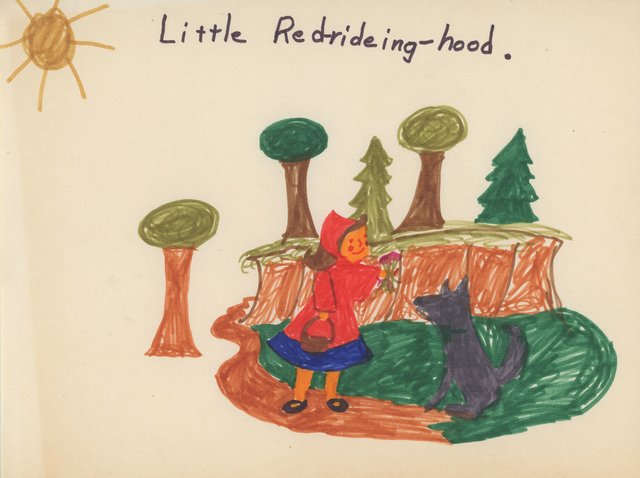
I drew this when I was about six
Little Red Riding Hood arrives at Grandma's to find a stranger in her grandmother’s bed.
“Granny, what big eyes you have,” says Little Red Riding Hood.
“The better to see you with, my dear,” says the wolf.
“Granny, what big ears you have!” says Little Red Riding Hood.
“The better to hear you with, my dear,” answers the wolf.
“Oh Granny, what big teeth you have,” says Little Red Riding Hood.
“All the better to eat you up,” cries the wolf as he pounces.
And she gets gobbled up, suffering the same fate as her grandmother.
Variations abound at this point. Some end with a woodcutter rescuing the pair from inside the wolf’s stomach. Some versions involve cutting the wolf open and filling him with stones so he sinks to the bottom of the river. In all of these accounts, the wolf never makes out well in the end.
The sexual symbolism and overtones in this particular story are undeniable. We all know the wolf symbolizes uncharted territory for a young and innocent girl as she blossoms into her womanhood. Her vulnerability and trust are exploited and she ends up literally devoured by her bedmate.
Today, we are more likely to encounter this tale stripped completely of any violent undertones; remarkably, we have retellings where the grandmother is only locked up in a closet – not devoured at all. All suggestions of the wolf and his symbolism for deflowering a young girl have been obliterated.
No matter which version you are familiar with, let’s peel back the layers and reveal some of the ghastly origins of this tale. In all of these earlier accounts symbolic sexual references cannot be disputed. In one adaptation, the wolf eats Red Riding Hood after she goes to bed with him.
My post today will introduce a truly bizarre spin you probably have never heard before.
The tale I am referring to is from an oral variation before Charles Perrault's retelling; this one is called The Story of Grandmother.
The wolf in this story is more of a werewolf, and he fully intends to have his way with the seemingly unaware young girl. As in the popular version, he arrives at grandmother’s house first, slaying her in her own home. Chopping her into pieces, he invites the young visitor to help herself to plate of remains from her grandmother and tricks her into cannibalism. She is offered a goblet of wine which is really her grandmother’s blood.
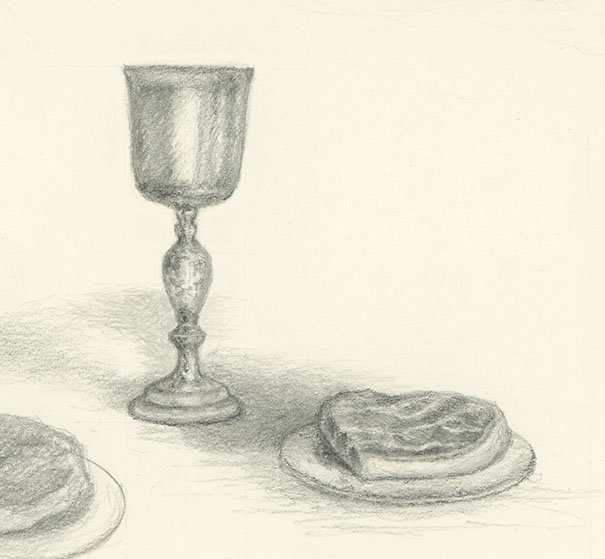
The “wolf” then invites her to join him in bed. He instructs her to strip naked and toss her clothing into the fire, as she won’t be needing them anymore.
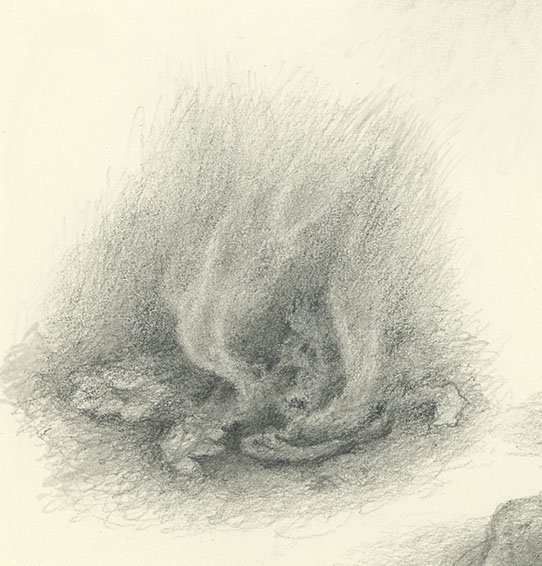
Now we get to probably the most bizarre part. By now, she realizes the wolf is clearly not who he claims to be (maybe she has always known this). Before getting into bed with him, she claims a sudden need to defecate and would prefer not to mess up the bed. The wolf begrudgingly agrees, but not before tying some string around her foot so she won't escape. As he grows impatient waiting, he calls out to her suggesting she must indeed be dropping quite a load. However, in the interim she freed herself by tying the string to something else and runs back home.
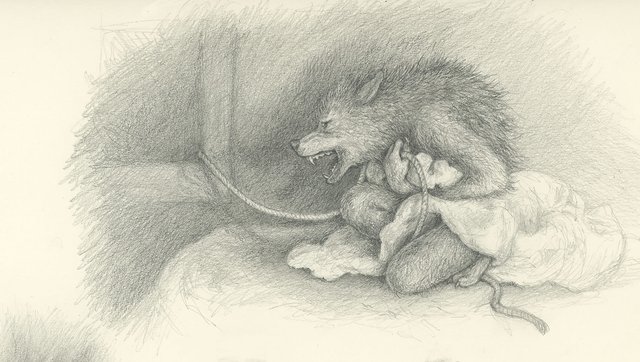
This version is unusual because the heroine relies on her own smarts to get out of a precarious situation. She is not saved by a woodsman or any other adult figure. Yes, she uses an embarrassing pretense to escape, but we can’t help but be impressed with her cleverness and jolted by the bawdy humor.
If all of this seems too much, remember, fairy tales were never intended to be used as stories for telling children. They were like a cultural weaving of stories collected through the ages passed on. Like cave paintings – they are records of lives lived in scattered villages across the forests of Europe during dangerous times. Life wasn’t always so good. Legends grew out of tragedies that regularly wiped out entire populations through fire, plague, and war. People may have used these tales as a way to cope with horrible situations and sudden unexplained deaths of loved ones. Fairy tales were culturally significant, instilling a sense of community as well as serving as a reminder of societal expectations told in story form.
It wasn’t until the latter half of the 19th Century that the collection of such stories were gathered together and presented as suitable stories for children. This evolution, then, of cleaning up the more unpleasant and violent aspects of fairy tales makes sense.
I’m certainly not an advocate for reading uncensored versions to children. But I am fascinated about these tales’ origins and how they evolved into the homogenized interpretations our culture is familiar with today. I worry we do a disservice to children’s imaginations by trying to protect them from creative ways of coping with life’s uncertainties in ways they can understand and relate to. For example, if you want to talk to your children about the importance of being careful with strangers, Little Red Riding Hood would be a good story to tell them. They can handle it.
It’s more meaningful to a child to use storytelling as a way of learning life’s lessons. But it becomes less so if we have to change every child's favorite set of words "Once upon a time" into the latest craze "Warning, trigger alert."
What do you think?
Drawings © Johanna Westerman 2016
nice story
Great work, again! I have had the chance to imagine and share the different takes on this story with many different people over the years. Glad to see your work in relation to this classic and thank you for sharing. Namaste :)
You are fortunate, @eric-boucher. Not many know the different variations. And they are cross cultural -
Thank you
I just wanted to say @fairytalelife, I really enjoy your posts and your work. I don't think I would ever have been into this type of art before but you have converted me. Keep up the amazing work and keep posting it!
Wow, thanks, @dexter-k. That keeps me inspired to create more!
"I drew this when I was about six" and you still have it!! damn, great parents.
amazing art and writing @fairytalelife
very interesting history and I tend to agree that we underestimate our children so we sweeten things up for them when actually, they can handle a lot if we're there with them supporting them! Specifically, I MUCH prefer the story of a clever little red riding hood rather than a rescued one.
You got that right, @natureofbeing. Thank you indeed!
nice trophy
I've never that ending before -- it's the best. The wolf left looking foolish, squeemish. I hope she didn't flush.
@richardjuckes, isn't that the craziest version?
great art @fairytalelife, nice 6 years old drawing, now I see that you are talented from your childhood. I think children see the tales a little differently, they see all this imagery and perceive them as some message. if you tell stories without all the details, they will not receive the message.
Thanks, @nekromarinist. I agree with you. They have been around for a long time for a reason.
shume ide e mire
duhet te flasesh anglisht! nuk te kupton njeri